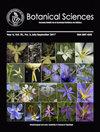<em>Oreopanax</em>属(五香科),墨西哥xoco玉米粉蒸肉复合食品
IF 0.7
4区 生物学
Q3 PLANT SCIENCES
引用次数: 0
摘要
背景:基于“植物物种综合体”的概念,将其定义为具有当地名称和形态,芳香和疗效的群体,我们分析了墨西哥韦拉克鲁斯州用于玉米肉馅包装的三种Oreopanax属植物的叶子,称为“xocos”或“chocos”,寻找共同特征。 问题:Oreopanax属的叶子是否形成了具有相同化学和解剖特征的民族植物学食物复合体?研究物种/资料描述:Oreopanax属的三个物种:O. capitatus, O. echinops和O. flacaccident的叶子。 研究地点和日期:O. capitatus和O. echinops的叶子于2021年1月25日和26日在Veracruz Xalapa的Instituto de Ecología, a.c.的Clavijero植物园中被收集;在韦拉克鲁斯州的Atapalchico、Tlacolulan和Veracruz收集到了O. flacaccident的叶子。 方法:化学分析包括从所研究物种的叶子中提取油,然后将其注入气相色谱仪和质谱联用(GC-MS)。解剖分析包括:固定、石蜡切片和叶片切片染色。使用复合显微镜在明亮视野或紫外线下进行观察。 结果:我们首次报道了三种被分析物种中常见的主要挥发性化合物(几种脂肪族和芳香族醇和萜类)。这三种植物在叶肉和叶中脉的皮层上都有树脂管。 结论:所研究的Oreopanax物种由于具有相似的用途、气味和味道,形成了一个民族植物学食品复合体。本文章由计算机程序翻译,如有差异,请以英文原文为准。
Anatomical and chemical characterization of leaves from <em>Oreopanax</em> spp. (Araliaceae), the Mexican xoco tamale food complex
Background: Based on the concept of “plant species complex,”, defined as a group sharing local names and morphological, aromatic, and curative properties, we analyzed the leaves of three species of the genus Oreopanax that are used as wrappers for tamales called “xocos” or “chocos” in Veracruz, Mexico, searching for common traits.
Question: Do leaves of the genus Oreopanax form an ethnobotanical food complex sharing chemical and anatomical characteristics?
Studied species / data description: Leaves from three species of the genus Oreopanax: O. capitatus, O. echinops, and O. flaccidus.
Study site and dates: Leaves of O. capitatus and O. echinops were recollected on January 25 and 26, 2021, in the Clavijero Botanic Garden of the Instituto de Ecología, A. C. in Xalapa, Veracruz; leaves of O. flaccidus were recollected in Atapalchico, Tlacolulan, Veracruz.
Methods: Chemical analyses consisted of oil extraction of the studied species' leaves, which were then injected into a gas chromatographer coupled to a mass spectrometer (GC-MS). Anatomical analyses included: fixation, paraffin sectioning, and staining of leaf sections of the three species. Observations were performed with a compound microscope using a bright field or UV light.
Results: For the first time, we are reporting major volatile compounds common in the three analyzed species (several aliphatic and aromatic alcohols, and terpenoids). The three species present resin canals in the mesophyll and the cortex of the midrib of the leaf.
Conclusions: The studied Oreopanax species form an ethnobotanical food complex since they share similar uses, smells, and tastes.
求助全文
通过发布文献求助,成功后即可免费获取论文全文。
去求助
来源期刊

Botanical Sciences
Agricultural and Biological Sciences-Plant Science
CiteScore
1.90
自引率
21.40%
发文量
71
审稿时长
16 weeks
期刊介绍:
Botanical Sciences welcomes contributions that present original, previously unpublished results in Botany, including disciplines such as ecology and evolution, structure and function, systematics and taxonomy, in addition to other areas related to the study of plants. Research reviews are also accepted if they summarize recent advances in a subject, discipline, area, or developmental trend of botany; these should include an analytical, critical, and interpretative approach to a specific topic. Acceptance for reviews will be evaluated first by the Review Editor. Opinion Notes and Book Reviews are also published as long as a relevant contribution in the study of Botany is explained and supported.
 求助内容:
求助内容: 应助结果提醒方式:
应助结果提醒方式:


